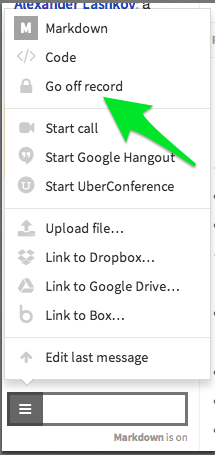Who should own the messages of the messenger users: Kato.im experience

Not so long ago, the news that Facebook has changed its data usage policy and will begin to transfer information about users to third parties without special permission from these same users has stirred up the news . Despite the fact that the news was shamelessly inflated by journalists, and in fact the rules of the social network did not change much, users were seriously worried about the privacy and security of their data.
Since our project Kato.im is a messenger for business communications, it would be logical to talk about how we store data, including the history of messages sent by the user, as well as who and in what situation can access this information.
Who owns the posts
The answer to this question depends on which version of the product is used - commercial or free.
We consider both cases in more detail.
Kato enterprise
Paradoxically, the situation with access to data is described very simply in a more complex paid version of the product: all the information belongs to the one who pays for the service.

Each instance of Kato Enterprise (the paid version at the time of writing is in beta testing) is a closed "universe" consisting of teams of employees, rooms, users participating in them, as well as settings that determine the rules for the functioning of this "universe." Entities (users, their access rights, sent messages, visibility rules, etc.) can interact with each other only within this “universe”. All dialogs in 1: 1 mode inside this “universe” belong to the company that pays for Kato Enterprise - just like this company owns all documents created by employees, including the email they sent (this is also a kind of document).
Kato teams
The case of the free version of the product, called Kato Teams, is easiest to illustrate with an example.
Petya and Olya own a consulting company and use the free version of Kato, Kato Teams for communications. A major customer of their company, SuperTechnologies LLC, also uses Kato Teams. When this client invites Petya and Olya to their team in the Kato service, consultants will also be able to communicate with employees of this company. For communication with the client and personal communication in 1: 1 mode, they will not have to switch context, as can be seen from the following figure.

Thus, Petya and Olya will be able to continue communication with each other in the 1: 1 mode, as well as exchange messages in the rooms of SuperTechnologies LLC. The story in room 1: 1 will belong to each of the interlocutors (as an e-mail), and in the rooms with a larger number of participants, to the team that owns the rooms. Despite the possibility of connecting to several teams, a personal chat in the 1: 1 mode is always one and exists independently, being completely under the control of the interlocutors. We emphasize once again that in the version of Kato Enterprise, the company that pays for access to the service retains control even with respect to dialogs between team members in a 1: 1 mode.
When the contract with the customer expires, Petya and Olya will be removed from the team of SuperTechnologies LLC and will not be able to see what is happening in the rooms with the participation of the organization’s employees, but they will retain control over the 1: 1 room. If subsequently Petya and Olya decide to close their company and remove the team from Kato, then they will no longer be connected within the service and will disappear from each other’s contact list in Kato.
In the event that later Petya gets a job in a company that uses Kato Teams, and this organization also invites Olya, the history of their messages in 1: 1 mode will be restored from the moment at which she broke off when the consulting company team was removed - “Continuity” of the history of personal communication is one of the differences between Kato and other instant messengers.
Edited Posts
In Kato, you can edit a message only if two conditions are met:
- This message is the last sent by the user in this particular room;
- In addition, it was sent less than 120 seconds ago (that is, less than two minutes have passed since it was written to the database).
Only the last edit is saved - Kato has no history of message changes and the fact that it was edited does not appear in the database.
In the Kato system, edited messages are highlighted with a pencil icon, which disappears if the room is closed and reopened.

This functionality is designed to correct minor inaccuracies and typos, while it does not allow you to significantly change the history of messages in the rooms.
Deleted Messages
In Kato, you cannot physically delete a message from the database. Administrators can “hide” messages by marking them as “deleted” (but not in rooms 1: 1), however this only hides the text of “deleted” messages from non-administrators. The message itself is stored in the database, and the administrator can cancel the pseudo-delete flag at any time.
There are no physical deletion of messages in the service for three reasons:
- Removing a message from the database does not mean that it was not copied in another way, for example, just by taking a screenshot.
- If the message was deleted after backing up the database, then sometimes it can still be restored from a copy of the database.
- A “deleted” message could be saved in a file as a result of the execution of the “Download History” function.
Off the record
There is no deletion of messages from the database in Kato, however, there is a special mode, the inclusion of which prevents messages from being stored in the database. It is called Off the record and is activated in the menu:

After turning on this mode, messages cease to be stored in the database - if the room is closed and reopened, then all messages sent in Off the record mode will disappear. Messages sent in this mode are marked with a red vertical bar on the left:

If you disable Off the record mode, then all subsequent messages in this room will be written to the database again.
In the event that the possibility of disabling the recording of history in the database is undesirable, team administrators can prohibit the Off-the-record mode.
Conclusion
The main reason that the Kato Teams product has become free is that if you take payment for each team connected to the service (in a large company, as a rule, a lot of teams are created), then the organization is forced to pay several for the same person times (as some employees are part of several Kato teams at the same time).
In the paid version (Kato Enterprise), companies pay a certain number of licenses corresponding to the number of company employees using Kato. In the future, employees can create any number of teams and invite both colleagues and external contractors to them. Moreover, the whole story in the rooms and in private chats in 1: 1 mode belongs to the company that paid for access to the service.
The free version (Teams Teams), on the contrary, allows users to maintain flexibility and work with the same “identity card” in different companies - this feature is especially demanded by consulting specialists and employees of various agencies.
In continuation of the topic, in the next article we will talk about how support for very large teams is organized in Kato.
